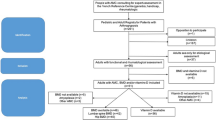Abstract:
Familial dysautonomia (FD) patients suffer from multiple fractures and have reduced bone pain, which defers the diagnosis. The pathogenesis of bone fragility in FD is unknown. This study aimed to characterize bone mineral metabolism and density in FD. Seventy-nine FD patients aged 8 months to 48 years (mean age 13.9 ± 10.4 years, median 12.3) were studied. Clinical data included weight, height, bone age, weekly physical activity and history of fractures. Bone mineral density (BMD) of the lumbar spine (n= 43), femoral neck (n= 26), total hip (n= 22) and whole body (n= 15) were determined by dual-energy X-ray absorptiometry. Serum 25-hydroxyvitamin D3, osteocalcin, bone alkaline phosphatase (B-ALP), parathyroid hormone and urinary N-telopeptide cross-linked type 1 collagen (NTx) were determined in 68 patients and age- and sex-matched controls. Forty-two of 79 patients (53%) sustained 75 fractures. Twenty-four of 43 patients had a spine Z-score <–2.0, and 13 of 26 had a femoral neck Z-score <–2.0. Mean femoral neck BMD Z-score was lower in patients with fractures compared with those without (–2.5 ± 0.9 vs –1.5 ± 1.0, p= 0.01). Mean body mass index (BMI) was 16 kg/m2 in prepubertal patients and 18.4 kg/m2 in postpubertal patients. Bone age was significantly lower than chronological age (75.5 vs 99.3 months in prepubertal patients, p<0.001; 151 vs 174 in post-pubertal patients, p<0.05). NTx and osteocalcin levels were higher in FD patients compared with controls (400 ± 338 vs 303 ± 308, BCE/mM creatinine p<0.02; 90 ± 59.5 vs 61.8 ± 36.9 ng/ml, p<0.001, respectively). B-ALP was lower in FD patients compared with controls (44.66 ± 21.8 vs 55.36 ± 36.6 ng/ml, p<0.04). Mean spine Z-score was significantly lower in physically inactive compared with active patients (–3.00 ± 1.70 vs –1.77 ± 1.3, respectively, p= 0.05). We conclude that fractures in FD patients are associated with reduced BMD. FD patients have increased NTx and osteocalcin. Contributing factors include reduced BMI, failure to thrive and reduced physical activity. Preventive therapy and early diagnosis are essential.
Similar content being viewed by others
Author information
Authors and Affiliations
Additional information
Received: 21 May 2001 / Accepted: 27 November 2001
Rights and permissions
About this article
Cite this article
Maayan, C., Bar-On, E., Foldes, A. et al. Bone Mineral Density and Metabolism in Familial Dysautonomia . Osteoporos Int 13, 429–433 (2002). https://doi.org/10.1007/s001980200050
Issue Date:
DOI: https://doi.org/10.1007/s001980200050




